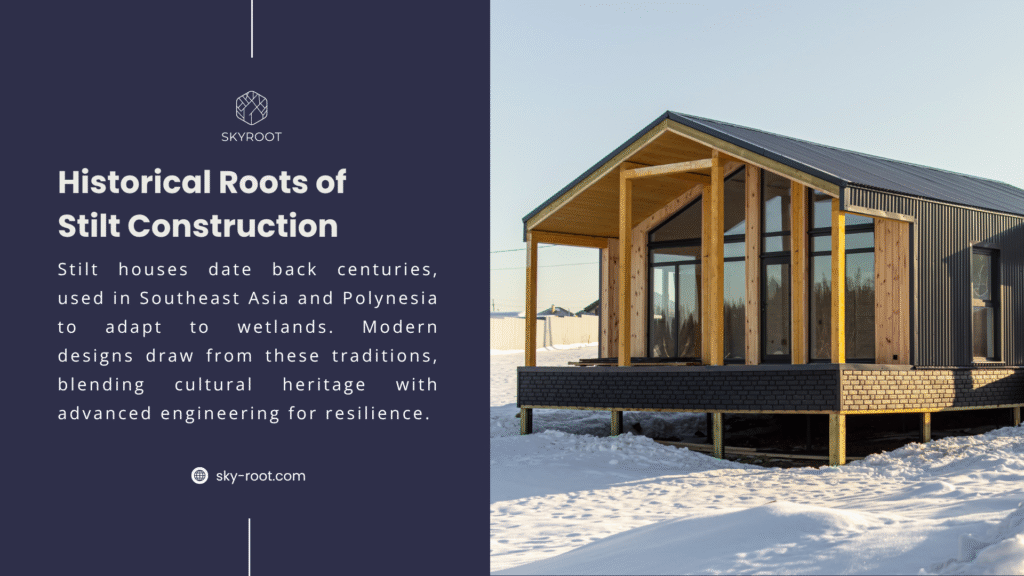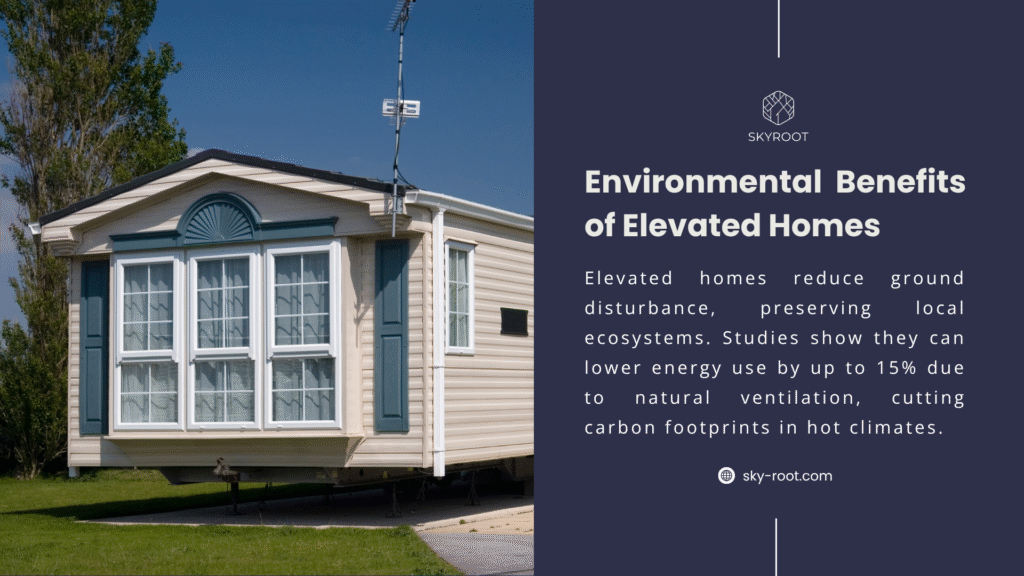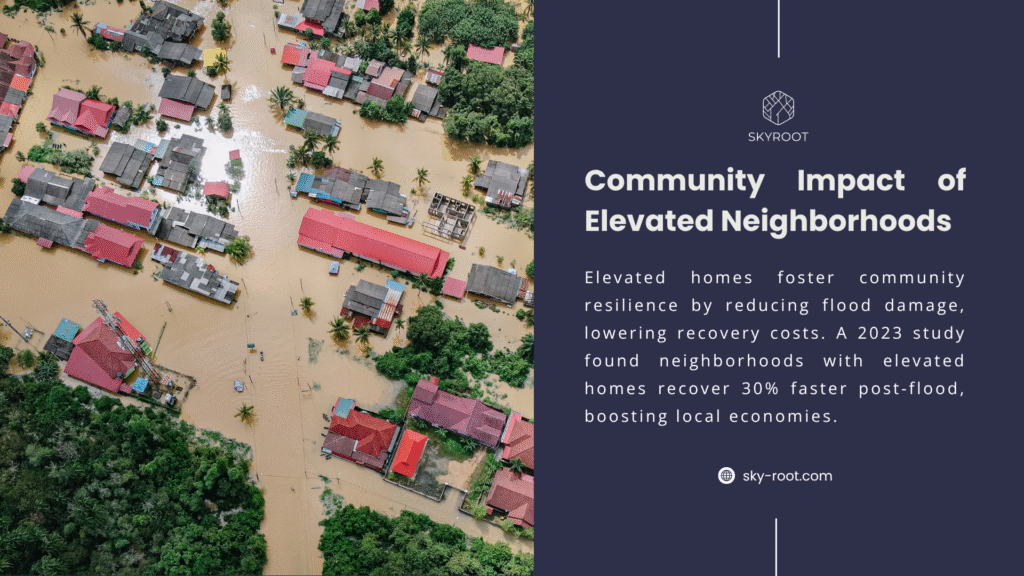You’ve probably seen them around – houses that look like they’re standing on stilts, sitting up high off the ground. Maybe you thought they looked weird at first, or wondered why someone would build like that. Turns out, there are some pretty solid reasons why more people are choosing to build an elevated house these days.
It’s not just about avoiding floods anymore, though that’s still a big part of it. People are figuring out that raising your house up actually makes it work better in a bunch of different ways. Plus, it gives you some extra space underneath that you can actually use for stuff.

Why Put Your House Up on Stilts?
The flood thing is obvious; water flows under instead of through your living room. But there’s more going on here than just staying dry.
Ever notice how much cooler it feels under a deck or pavilion on a hot day? The same thing happens under an elevated house. All that air moving around underneath keeps the whole place cooler.
That empty space under there isn’t really empty either. You can park cars, store stuff, set up a workshop, or just hang out in the shade. It’s like getting a whole extra level without paying for a full second story.

Your insurance company will probably cut you a break, too. Houses that sit above flood levels get better rates. Some folks save hundreds of dollars every year just from being up high enough.
Getting the Bottom Part Right
Here’s where things get tricky. You can’t just prop your house up on whatever and call it good. The foundation setup makes or breaks the whole thing.
Most people go with what’s called a pier and beam. Basically, you dig holes, pour concrete posts, and set your house on top of them. It works fine if your dirt is decent and you don’t need to go super high. The key is getting all those posts level and spaced right.
Sometimes you need to bring in a bunch of dirt to build up your lot first, then pour a regular concrete slab on top. It takes more work but sometimes it’s the only way to get high enough without breaking the bank.
For really challenging situations – soft ground, high winds, you need to go way up – there are pile foundations. These go deep, like really deep into the ground. Cost more, but they’re solid as a rock.
The thing about types of foundations for homes is that what works great in one spot might be terrible somewhere else. Soil makes a huge difference, so does how high you need to go, and what the weather’s like.
What to Build It Out Of
This matters more than you might think. When your house is up in the air, it gets hit with more weather, more wind, and fixing stuff later can be a pain.
Wood is still what most people use. Cheaper to start with, easy to work with, every contractor knows what they’re doing with it. But being up high means more exposure to rain and wind, so you might be doing more maintenance down the road.
Steel costs more up front, but it just doesn’t quit. No bugs eating it, no rot, no warping. If you’re going to the trouble of building up high, might as well build it to last.
Concrete is getting popular, especially where hurricanes are a thing. Expensive, but when bad weather comes through, concrete houses tend to still be there when the wood ones aren’t.
Brick and stone look great and last forever, but they’re heavy and need more engineering when you’re building up high. The brick vs wood house comparison changes when you factor in wind loads and foundation requirements. Same with stone vs brick house – both work, but the structural requirements get more complex.
If you’re trying to figure out the best material to build a house, elevated construction actually changes the equation quite a bit. What works great on the ground might not be the best choice when you’re building up.
Design Stuff That Actually Matters
How high should you go? Most people end up somewhere between 8 and 12 feet off the ground. Go too low and you’re not getting the benefits. Go too high and you’re spending a fortune on stairs and dealing with serious wind issues.
Speaking of stairs, don’t cheap out here. You’re going to walk up these things every single day, and they’re the first thing people see when they look at your house. Good stairs with proper railings run anywhere from $6,000 to $12,000, but it’s worth doing right.
What do you do with all that space underneath? You can’t just leave it open and hope for the best. Most people put up some kind of screening to keep out rain while still letting air flow through. Some folks get fancy with it and make it look like part of the design.
What’s This Going to Cost You?
Let’s talk real numbers here:
| What You’re Paying For | Regular House | Elevated House | Extra You’ll Pay |
| Foundation | $15,000-25,000 | $25,000-45,000 | $10,000-20,000 |
| Frame work | $20,000-35,000 | $23,000-40,000 | $3,000-5,000 |
| Getting utilities up there | $8,000-15,000 | $12,000-20,000 | $4,000-5,000 |
| Stairs you can’t avoid | $2,000-4,000 | $6,000-12,000 | $4,000-8,000 |
| Total extra cost | – | – | $21,000-38,000 |
These numbers come from different projects around the country, so your area might be different. The thing is, a lot of people make this money back pretty quickly through lower insurance and higher home values.
Dealing with Building Departments and Permits
This part can be a real headache. Building codes for elevated houses are way more complicated, especially if you’re in a flood zone. They’ll want to see that you’re high enough above the flood level, plus usually an extra foot or two just to be safe.
You’ll probably need an engineer to sign off on your plans. That adds time and money, but it keeps you out of trouble later. Building departments take these plans more seriously because elevated houses have to deal with different stresses than regular ones.
Start your permits early. Like, really early. Plan on it taking longer than a regular house permit because they have to check more stuff.
How Does This Compare to Other Ways of Building?

People ask about modular vs manufactured homes for this kind of construction. Modular can work. You get good quality construction done in a factory, then just set it on your elevated foundation. The problem is that getting a crane out there to lift it up gets expensive fast.
Manufactured homes are tougher because they’re not really built to handle the stresses of being up high. If you’re going elevated, stick-built or modular is usually your better bet.
Keeping It All Working
Elevated houses need different kinds of maintenance from regular ones. That space underneath becomes your job to take care of. It needs to stay clean and reasonably dry, which means hosing it down once in a while and keeping an eye out for bugs or other critters moving in.
The good news is that when something goes wrong with your plumbing or electrical, it’s usually easier to get to because everything’s accessible from underneath. No digging up your yard or tearing into walls.
Check your foundation posts once a year or so. Look for any settling or shifting. Most problems start small and stay small if you catch them early.
Build an Elevated House with Sky Root
Building an elevated house costs more up front – usually somewhere between $20,000 and $40,000 more than the same house built on the ground. But you get real benefits for that money: flood protection, lower energy costs, extra usable space, and usually higher resale value.
The key is working with people who know what they’re doing. Elevated construction isn’t necessarily harder than regular building, but it is different, and those differences matter. Get in touch with us and we’ll walk through what’s possible for your project.
